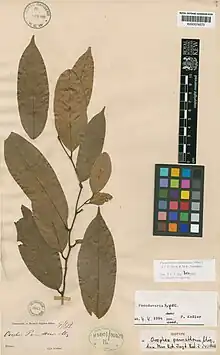| Pseuduvaria pamattonis | |
|---|---|
 | |
| Herbarium specimen of Pseuduvaria pamattonis.[1] | |
| Scientific classification | |
| Kingdom: | Plantae |
| Clade: | Tracheophytes |
| Clade: | Angiosperms |
| Clade: | Magnoliids |
| Order: | Magnoliales |
| Family: | Annonaceae |
| Genus: | Pseuduvaria |
| Species: | P. pamattonis |
| Binomial name | |
| Pseuduvaria pamattonis | |
| Synonyms | |
|
Hydnocarpus unonifolius Elmer Orophea pamattonis Miq | |
Pseuduvaria pamattonis is a species of plant in the family Annonaceae.[3] It is native to Borneo and the Philippines.[1] Friedrich Miquel, the Dutch botanist who first formally described the species using the basionym Orophea pamattonis, named it after a mountain in Borneo called Gunung Pamaton.[4]
Description
It is a tree reaching 22 meters in height. The young, yellow to gray-brown branches are slightly to densely hairy and also have sparse lenticels. Its egg-shaped to elliptical, slightly leathery to leathery leaves are 9-20 by 3–7.5 centimeters. The leaves have pointed to blunt bases and tapering tips, with the tapering portion 8-24 millimeters long. The leaves are hairless on their upper and lower surfaces. The leaves have 10-16 pairs of secondary veins emanating from their midribs. Its sparsely to very densely hairy petioles are 4-13 by 1–2.5 millimeters with a broad groove on their upper side. Its Inflorescences occur in groups of 2–7 on branches, and are organized on indistinct peduncles. Each inflorescence has 1-2 flowers. Each flower is on a densely hairy pedicel that is 4-11 by 0.3-0.7 millimeters. The pedicels are organized on a rachis up to 5 millimeters long that have 2 bracts. The pedicels have a medial, sparsely hairy bract that is 0.2-1 millimeters long. Its flowers are unisexual. Its flowers have 3 free, oval sepals, that are 0.5-1.5 by 0.7-2 millimeters. The sepals are hairless on their upper surface, sparsely to densely hairy on their lower surface, and hairy at their margins. Its 6 petals are arranged in two rows of 3. The white to yellow, oval, outer petals are 1-2 by 1-2 millimeters with hairless upper and densely hairy lower surfaces. The white to yellow, heart-shaped to diamond-shaped, inner petals have a 2-7 millimeter long claw at their base and a 4-10 by 2-5 millimeter blade. The tips of the male flowers have two concave sides while those of the female flowers are pointed. The bases of the male flowers are heart-shaped to flat while those of the female flowers are flat. The inner petals are densely hairy on their upper and lower surfaces. Male flowers have 30-45 stamens that are 0.5-0.8 by 0.4-0.6 millimeters. Female flowers have 6-7 carpels that are 1.4-1.6 by 0.6-0.9 millimeters. Each carpel has 3-5 ovules arranged in two rows. The female flowers have up to 6 sterile stamens. The fruit occur in clusters of 1–5 on sparsely to densely hairy pedicles that are 9-13 by 1–2.5 millimeters. The brown, globe-shaped fruit are 12-21 by 11-18 millimeters. The fruit are smooth, and very densely hairy. Each fruit has 3-5 hemispherical to lens-shaped seeds that are 9–11.5 by 6.5-9 by 2- millimeters. The seeds are wrinkly.[5]
Reproductive biology
The pollen of P. pamattonis is shed as permanent tetrads.[6]
Habitat and distribution
It has been observed growing in limestone and clay soils in lowland and mountain forests at elevations of 70–670 meters.[5]
References
- 1 2 "Pseuduvaria pamattonis (Miq.) Y.C.F.Su & R.M.K.Saunders". Plants of the World Online. The Trustees of the Royal Botanic Gardens, Kew. n.d. Retrieved August 2, 2021.
- ↑ Verspagen, N.; Erkens, R.H.J.; Daniels, A. (2021). "Pseuduvaria pamattonis". IUCN Red List of Threatened Species. 2021: e.T179886831A179886833. doi:10.2305/IUCN.UK.2021-2.RLTS.T179886831A179886833.en. Retrieved 20 June 2022.
- ↑ "Pseuduvaria pamattonis (Miq.) Y. C. F. Su & R. M. K. Saunders". Catalogue of Life. Species 2000. n.d. Retrieved August 2, 2021.
- ↑ Miquel, F.A. Guil. (1865). "Anonaceae Archipelagi Indici". Annales Musei botanici lugduno-batavi. 2: 1–45.
- 1 2 Su, Yvonne C.F.; Saunders, Richard M.K. (2006). Monograph of Pseuduvaria (Annonaceae). Systematic Botany Monographs. Vol. 79. American Society of Plant Taxonomists. pp. 1–204. JSTOR 25027955.
- ↑ Su, Yvonne C. F.; Saunders, Richard M. K. (2003). "Pollen structure, tetrad cohesion and pollen-connecting threads in Pseuduvaria (Annonaceae)". Botanical Journal of the Linnean Society. 143 (1): 69–78. doi:10.1046/j.1095-8339.2003.00204.x. ISSN 1095-8339.
